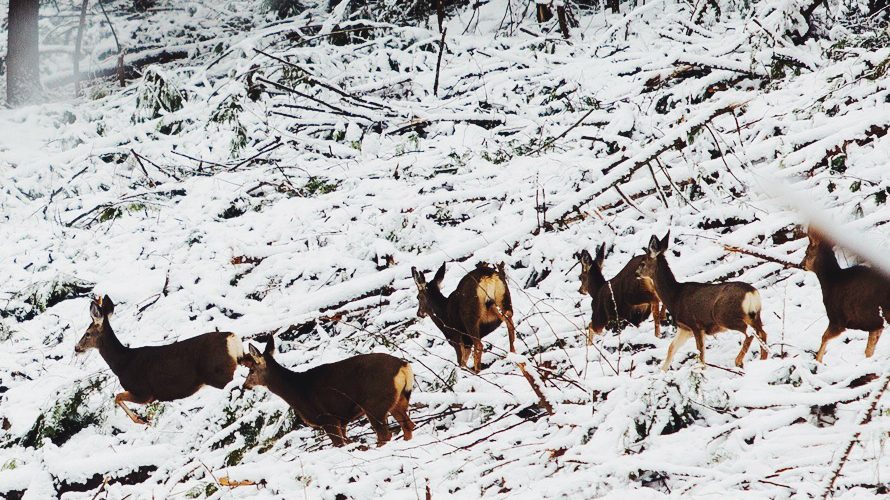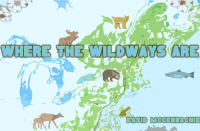With a recorded interview obtained in the field, the Wildlife Defence League revealed some powerful information: an individual working for the caribou recovery project in British Columbia admitted to fitting a radio collar onto a wolf, then using it to track down and kill the wolf’s pack members. The worker also revealed that this “Judas wolf” has been kept alive, so any new pack members the wolf acquires can be killed.
With a recorded interview obtained in the field, the Wildlife Defence League revealed some powerful information: an individual working for the caribou recovery project in British Columbia admitted to fitting a radio collar onto a wolf, then using it to track down and kill the wolf’s pack members. The worker also revealed that this “Judas wolf” has been kept alive, so any new pack members the wolf acquires can be killed. While a BC government spokesperson denied the claim that a Judas wolf was kept alive last year, they have not responded to the allegation that a wolf was kept alive this year.
This development adds to a growing tally of complaints conservationists have with the BC government’s controversial wolf cull, which is part of the Mountain Caribou Recovery Implementation Plan, which was launched in 2014 and will continue until 2019. Not only do conservationists believe that the BC government has provided misinformed and inconsistent information, but they also argue that the wolf cull is unethical and cruel, based on inaccurate science, and ultimately won’t succeed. Yet the BC government insists it’s necessary to kill up to 200 wolves per year to save the critically endangered mountain caribou.
The mountain caribou is a unique type of woodland caribou that used to roam over vast areas of the Northwest United States and Southeastern Canada. This caribou population has dropped over 27 percent in the last 20 years, leaving approximately 1,700 individuals in 15 herds, with 99 percent of the caribou living in British Columbia. In the South Selkirk, a shocking 12 mountain caribou remain, making the species virtually extinct in that area. The problem is so serious that conservation groups like Wildsight and Conservation Northwest have actually voiced their support for the wolf cull, regarding it as a necessary last-ditch attempt to save these caribou herds. Yet organizations like Wildlife Defence League and Pacific Wild believe that the BC government needs to protect critical caribou habitat instead of targeting wolves.
Krista Roessingh of Pacific Wild explains that mountain caribou depend upon undisturbed old-growth forests for food and shelter. “The caribou can’t co-exist with industry,” she says. “Yet habitat has been destroyed at a rapacious rate.” Logging appears to be the primary cause of habitat destruction, but other industries such as coal mining, oil and gas exploration, as well as wind energy development have all contributed to a 66 percent drop in mountain caribou habitat in the South Peace region alone. These caribou are also incredibly sensitive creatures, and they’ve been known to place up to 18 kilometres between themselves and industrial sites, which means the zone of influence of these industries is far greater than their physical footprint.
Recreational activities such as snowmobiling and helicopter skiing also have a negative effect on caribou, producing noise pollution that’s been scientifically linked to increased stress in caribou, resulting in poor body condition, behavioural changes, and low calf production. Snowmobiling also packs down snow, creating highways for predators to easily access caribou. “Under natural conditions,” Roessingh says, “wolves prefer other prey, and caribou maintain spatial separation from wolves. But when wolves have access to caribou, they take them opportunistically.”
The BC government claims to have protected 2.2 million hectares in the South Peace region for the endangered caribou herds, but conservationists argue that there is little evidence that some of the most important habitat – large intact areas of old-growth forest at low- and mid-elevations on gentle slopes – has been protected. “Much of that habitat type has been lost or fragmented with roads, cutblocks, cutline and pipelines,” says Roessingh, “which is the lead cause of caribou decline. Conservationists are also concerned about the lack of connectivity between intact protected forests. Breaking the forest up into small patches changes the caribou’s movement patterns, makes them more vulnerable to predation, and last but not least, encourages interbreeding. Small, isolated herds have lower genetic diversity and resilience, making them vulnerable to a host of problems.
The Wildlife Defence League wasn’t able to find the cull, but the group did gather evidence about the destructive logging happening in critical caribou habitat.”
In 2015, the Wilderness Committee obtained briefing notes from a 2014 meeting between the BC government and the forestry industry through a Freedom of Information request. The notes revealed that the two parties work closely together and showed that the forestry industry encouraged a wolf cull for the purpose of avoiding further logging restrictions. “Actions within the Mountain Caribou Recovery Implementation Plan have largely been implemented with the exception of effectively managing wolf populations,” the briefing notes state. “Industry has criticized government for failing to effectively implement this recovery action, and will be very reluctant to forego additional harvesting opportunities to meet any additional habitat targets imposed by the federal recovery strategy.” In an interview with The Globe and Mail, Wilderness Committee Director Gwen Barlee, who filed for the Freedom of Information application, asked an incisive question: “Are we having the BC government write recovery strategies for species at risk, or are we having logging companies writing recovery strategies for species at risk?”
While the revelation of the Freedom of Information briefing notes might have astonished some, Roessingh explains that collusion between the logging industry and the provincial government is a well-established fact: “It’s no secret. There’s been collusion ever since there’s been a logging industry. Multinational logging companies are some of the biggest supporters of the governing liberal party right now.”
What’s more concerning to Roessingh is that the BC government doesn’t have any endangered species legislation on a provincial level, which may allow the province to continue destroying critical caribou habitat without any real consequences. On a federal level, caribou are protected under the Species at Risk Act (SARA), which states that critical habitat for any endangered or threatened species must be preserved. But there’s a loophole that allows the province to avoid this legal obligation. SARA specifies that critical habitat should be “effectively” protected by provincial laws – not federal laws. The federal government would intervene only if the federal minister didn’t believe the provincial laws did enough to protect critical habitat, which would result in the Governor in Council of Canada ordering the province to take appropriate action. Yet to date, the federal government hasn’t stepped in.
Enter the grey wolf, a species that’s been maligned and persecuted for centuries by European settlers. Although the BC government’s management plan for the species suggests that the grey wolf has a “widespread, large population with no evidence of decline,” Roessingh points out that no population surveys have actually been conducted in the province, and that British Columbia enforces no limitations on the recreational killing of this species. “There’s no mandatory recording for hunters who kill wolves,” she says. “The numbers that the government uses are based only on the numbers of ungulates in a given area.” In 2014, the BC government estimated that there were between 5,300 and 11,600 wolves in the province; yet such a large range leaves plenty of uncertainty. While Roessingh doesn’t believe the current wolf cull will have an irreversible effect on the wolf population, she points out that wolf populations are far lower than what they were in the early 1900s.
Besides these wolf population doubts, studies show that wolves may not be the primary predator of caribou. In the South Peace, for example, wolves are “suspected to account for an estimated 40 percent of caribou predation, with cougars and grizzlies likely taking up the balance.” What’s more, taking wolves out of the ecosystem may have harmful effects on the ecosystem. “There’s a lot of research that shows the negative effects of removing wolves from places,” Roessingh explains. “Because wolves are so wide-ranging and fast travellers, they strongly influence wildlife and ecosystems, from individual behaviour to system dynamics, from ecological to evolutionary time scales. Wolves also control prey populations as well as smaller predators, which in turn benefits ecosystem structure and biodiversity.”
Despite this research on the wolf’s beneficial role in the environment, the BC government has allocated 2.2-million dollars to kill to up to 200 wolves per year over a five-year period. The killing method is incredibly inhumane: contractors from Bighorn Helicopters use machine guns to indiscriminately shoot wolves from the air, and conservationists believe the animals suffer immensely. “The idea that wolves can be killed with one shot from a helicopter is a complete lie,” says Tommy Knowles, founder of the Wildlife Defence League. “They’re being gunned down and sometimes shot in the hind leg, or shot in the hips and then running into the forest. We can’t confirm it, but we assume that they’re dying very slowly, and these so-called ‘sharp shooters’ aren’t able to kill them right away.”
The BC government’s decision to cull wolves led Pacific Wild and the Valhalla Wilderness Society to file a petition with the Forests, Lands, and Natural Resource Ministry to request the immediate cessation of the wolf cull. At the time of writing this article, Roessingh reported that Pacific Wild has received a response from the provincial government, but there was no indication that the cull would be stopped, or that the government had adjusted its plans to tackle the real cause of caribou decline – habitat destruction. “We’re working on the next step,” Roessingh says.
While Pacific Wild has taken a legal angle, members of the Wildlife Defence League hit the snowfields with cameras and recording equipment to monitor, document, and expose the wolf cull to the public. The group did a lot of tracking by foot, battling deep snow and hazardous terrain. They also surveyed the South Selkirk and South Peace regions in a Cessna plane. Despite their best efforts, the Wildlife Defence League wasn’t able to find the cull, but the group did gather evidence about the destructive logging happening in critical caribou habitat. “Logging continues to decimate wildlife habitat across British Columbia,” says Knowles. “Our fieldwork demonstrated that active logging is taking place in caribou recovery areas.”
Logging activity may be continuing, yet Knowles believes the industry feels threatened, which suggests that conservation efforts are making a difference. “When our photographer Sam was taking photos of a truck full of logs,” Knowles reports, “a trucker got out and said, ‘What are you guys? A bunch of environmentalists?’ They’re very defensive about what they’re doing because they know environmentalists are threatening their way of making money.”
Knowles also reports that most people living in the South Selkirk region are well aware that logging is the true reason for caribou decline. “People we spoke to consistently said, ‘have you seen all the logging trucks that have been going down the roads?’” Knowles says. “I think a lot of people in that area feel that wolves are being scapegoated and caribou never really stood a chance.”
One of the biggest pieces of evidence the Wildlife Defence League uncovered this year was the audio recording that proved the existence of a Judas wolf, and showed that this wolf was being kept alive so the government could kill any new pack members. “It’s pretty powerful stuff,” Knowles says. “When we heard the individual in the recording disclose information about the Judas wolf, it was truly heartbreaking. If watching your family killed by snipers in helicopters is what the government considers a ‘humane’ cull, I shudder to imagine what they consider inhumane.” The Wildlife Defence League has called upon the BC government to respond to the evidence in the recordings, but the organization hasn’t received a response. “We believe the government is intentionally avoiding responding to the audio clips,” says Knowles.
The Wildlife Defence League will continue its wolf defence campaigns as long as the cull persists. Knowles hopes their efforts are stirring public opinion and pushing people to take action. “I think the biggest thing to remember is that the wolf cull is a political move by the BC Liberal government,” Knowles says. “The BC Liberals have absolutely no intention of conserving caribou in the province, and have every intention of allowing industrial expansion to continue. Wolves shouldn’t have to die for mistakes made by humans. We’re hoping that our work will ensure that future governments are not able to scapegoat wolves.”














